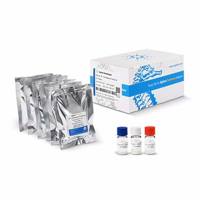Protein-induced DNA bending plays a key role in many essential biological processes, such as DNA replication, recombination, and transcription, and can be analyzed by a variety of biochemical and biophysical methods, such as electrophoresis mobility shift assay (EMSA), X-ray crystallography, nuclear magnetic resonance (NMR), and DNA ring closure assay. In this chapter, I will provide a detailed protocol for studying protein-induced DNA bending by utilizing the plasmid pBendAT. pBendAT carries a 230 bp DNA segment containing five pairs of restriction–endonuclease recognition sites and can be used to produce a set of five DNA fragments of identical length, with each fragment having a different positioning of a protein-binding site. Binding of a protein to this site will divide a DNA fragment into two DNA segments. If protein binding leads to DNA bending, then the two DNA segments will be at an angle to each other and the distance between the DNA ends will shorten. As a result, the gel mobility of the protein–DNA complex will be affected as the mobility of a rigid DNA fragment is inversely proportional to the end-to-end distance. Therefore, by analyzing how the position of protein binding within a fragment affects the gel mobility of the protein–DNA complexes, we are able to determine the DNA bending angle and the location of the bend. The DNA fragments of identical length can also be conveniently generated by PCR amplification using pBendAT as the DNA template. Since the 230 bp DNA fragment of pBendAT does not contain more than two consecutive AT base pairs, pBendAT is particularly suitable for the assessment of DNA bending induced by proteins recognizing AT-rich DNA sequences cloned in the 230 bp DNA fragment.






